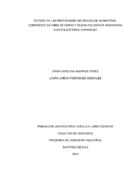Mostrar el registro sencillo del ítem
Estudio de las propiedades mecánicas de un material compuesto de fibra de vidrio y resina polimérica modificada con poliestireno expandido
| dc.contributor.advisor | Ordoñez Ñañez, John Edward | |
| dc.creator | Andrade Peréz, Diana Carolina | |
| dc.creator | Rodríguez González, Laura JImena | |
| dc.date.accessioned | 2020-05-08T00:56:40Z | |
| dc.date.available | 2020-05-08T00:56:40Z | |
| dc.date.created | 2019 | |
| dc.identifier.uri | http://hdl.handle.net/20.500.12237/1810 | |
| dc.description | Actualmente, la búsqueda de nuevos materiales ha impulsado diferentes investigaciones con el fin de obtener mejoras en sus propiedades. Los materiales compuestos son combinaciones macroscópicas de dos o más materiales diferentes mezclados en el mismo sistema. Algunos materiales compuestos se encuentran disponibles naturalmente, como la madera o el hueso, sin embargo, la gran mayoría de los materiales compuestos utilizados en la actualidad son diseñados y fabricados por el hombre. Estos materiales surgen de la necesidad de obtener mejoras a las propiedades de cada uno de los componentes por separado, por ejemplo, en la industria del transporte son necesarios materiales ligeros, rígidos, resistentes al impacto, resistentes a la corrosión y el desgaste, propiedades que rara vez se ven juntas, el primer automóvil en usar materiales compuestos para su estructura fue el Lotus Elite Colín Chapman en 1957, que usó varios moldes de GRP (glass reinforced plastic) pegados para armar un monocasco de material compuesto. Antes de esto, en los años 50, el Ford Thunderbird y el Chevrolet Corvette habían usado plástico reforzado con vidrio (GRP) para parte de la estructura y componentes de la carrocería, mientras que Citroën lo utilizaba para el panel de techo en el DS. De igual manera, con la tecnología que se tiene actualmente, es posible diseñar materiales compuestos reforzados con fibras, con la finalidad de obtener una elevada resistencia específica y modulo específico, que corresponden respectivamente, a las relaciones entre la resistencia y la tracción y el peso específico y entre el módulo de elasticidad y el peso específico. Usando materiales de baja densidad, tanto para la matriz como para el refuerzo, se fabrican compuestos reforzados que tienen resistencias y módulos específicos altos, como es el caso de los metales (W, Mo, Nb, etc.), los cuales tienen un módulo de elasticidad elevado, no se oxidan y tienen baja densidad El presente trabajo aporta a esta área de investigación un estudio sobre la mejora de la fibra de vidrio con la adición de polietileno expandido (EPS) aportándole al composito original propiedades mecánicas. Este proyecto se desarrolló en 3 etapas, las cuales se componen de Establecer el proceso de fabricación del material compuesto a partir de fibra de vidrio y resina polimérica modificada con EPS, en una segunda etapa se estableció construir las probetas que permitieron evaluar el comportamiento mecánico de las diferentes proporciones del material compuesto respecto a las de la FV y finalmente una tercera etapa que permitió comparar el desempeño de las propiedades mecánicas del material compuesto respecto a los materiales individuales donde se emplearon dos materiales comúnmente usados en la industria como lo son la fibra de vidrio (FV) y el poliestireno expandido (EPS) con el fin de estudiar un nuevo material compuesto cuya matriz fue la FV y como material de refuerzo se usó el poliestireno expandido. Por un lado, la FV es un material hecho de hebras o fibras extremadamente finas de vidrio tejido o entrelazado las cuales son unidas por una resina que las aglomera, esta estructura ha demostrado ser muy resistente a la vez que permite moldearse en diferentes formas, es por esto que cuentan con numerosas aplicaciones, desde automóviles hasta aislamiento en el hogar. Por otro lado, el EPS conocido en el país con el nombre de icopor por su fabricante, Industria Colombiana de Porosos, es un plástico usado con frecuencia para el desarrollo industrial y embalaje, está caracterizado por ser un material resistente a impactos lo que lo hace idóneo para esta aplicación además es un excelente aislante térmico por lo que es ampliamente usado en sistemas que requieran establecer un sistema cerrado, pero este material, posee un tiempo de degradación de 1000 años aproximadamente, lo que lo hace contraproducente para el medioambiente, además es un material poco atractivo para procesos de reciclaje debido a su bajo costo de producción y alto costo de recolección del mismo. Con el fin de caracterizar el material compuesto obtenido de la mezcla de la FV y el EPS, se propuso estudiar una combinación de estos precursores, evaluar las características mecánicas aportadas por el EPS y compararlas con las de FV sin polímero. Para este trabajo se realizaron diferentes muestras variando las concentraciones de resina y el compuesto con EPS, buscando que el producto presente la rigidez de la FV, pero a su vez la flexibilidad y resistencia del EPS. Este proyecto se desarrolló, además, con el fin de ofrecer una alternativa a la disposición final del EPS, el cual es un gran contaminante que afecta a los ecosistemas. | spa |
| dc.description.abstract | Currently, the search for new materials has promoted different investigations in order to obtain improvements in their properties. The materials compounds are macroscopic combinations of two or more different materials mixed in the same system. Some composite materials are found naturally available, like wood or bone, however the vast majority of the composite materials used today are designed and manufactured by man. These materials arise from the need to obtain improvements to the properties of each of the components separately, for example in the transport industry light, rigid materials resistant to impact, resistant to corrosion and wear, properties that are rarely seen Together, the first car to use composite materials for its structure was the Lotus Elite Colín Chapman in 1957, who used various GRP molds (glass reinforced plastic) glued together to make a monocoque of composite material. Before Of this, in the 1950s, the Ford Thunderbird and Chevrolet Corvette had used glass reinforced plastic (GRP) for part of the structure and components of the body, while Citroën used it for the roof panel on the DS. Of In the same way, with the current technology, it is possible to design fiber-reinforced composite materials, in order to obtain a high specific resistance and specific module, which correspond respectively, to the relationships between resistance and traction and weight specific and between the modulus of elasticity and the specific weight. Using materials of low density, both for the matrix and for the reinforcement, are manufactured reinforced compounds that have high specific modulus and resistance, such as This is the case of metals (W, Mo, Nb, etc.), which have a modulus of high elasticity, do not rust and have low density The present work contributes to this research area a study on the improvement fiberglass with the addition of expanded polyethylene (EPS) giving the original composite mechanical properties. This project was developed in 3 stages. which are made up of establishing the material manufacturing process made from fiberglass and EPS modified polymer resin, in a second stage it was established to build the test pieces that allowed evaluating the mechanical behavior of the different proportions of the composite material regarding those of the FV and finally a third stage that allowed to compare the performance of the mechanical properties of the composite material with respect to individual materials where two materials commonly used in industry such as fiberglass (FV) and expanded polystyrene (EPS) with in order to study a new composite material whose matrix was the PV and as material for reinforcement the expanded polystyrene was used. On the one hand, PV is a material made of extremely fine strands or fibers of woven or interwoven glass which They are joined by a resin that agglomerates them, this structure has proven to be very resistant while allowing it to be molded into different shapes, which is why They have numerous applications, from automobiles to insulation in the home. On the other hand, the EPS known in the country with the name of icopor for its manufacturer, Colombian Porous Industry, is a frequently used plastic for industrial development and packaging, it is characterized by being a material impact resistant which makes it ideal for this application is also a excellent thermal insulator so it is widely used in systems that require establishing a closed system, but this material has a time of degradation of approximately 1000 years, which makes it counterproductive for the environment is also an unattractive material for recycling processes Due to its low cost of production and high cost of collecting it. In order to characterize the composite material obtained from the mixture of the PV and the EPS, it was proposed to study a combination of these precursors, to evaluate the mechanical characteristics provided by EPS and compare them with those of PV without polymer. For this work, different samples were made, varying the concentrations of resin and EPS compound, seeking that the product present the stiffness of the PV, but at the same time the flexibility and resistance of EPS. East project was also developed in order to offer an alternative to the provision end of EPS, which is a major pollutant that affects ecosystems. | spa |
| dc.format.mimetype | application/pdf | spa |
| dc.subject | Poliestireno | spa |
| dc.subject | Propiedades mecánicas | spa |
| dc.title | Estudio de las propiedades mecánicas de un material compuesto de fibra de vidrio y resina polimérica modificada con poliestireno expandido | spa |
| dc.subject.subjectenglish | Polystyrene | spa |
| dc.subject.subjectenglish | Mechanical properties | spa |
| dc.rights.accessRights | info:eu-repo/semantics/openAccess | spa |
| dc.creator.degree | Ingeniero Industrial | spa |

